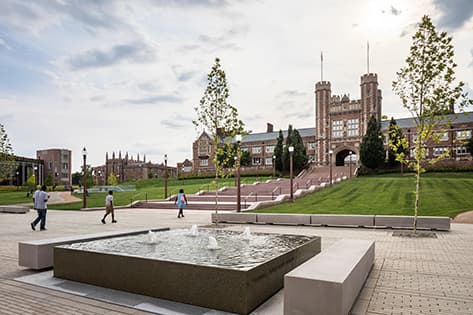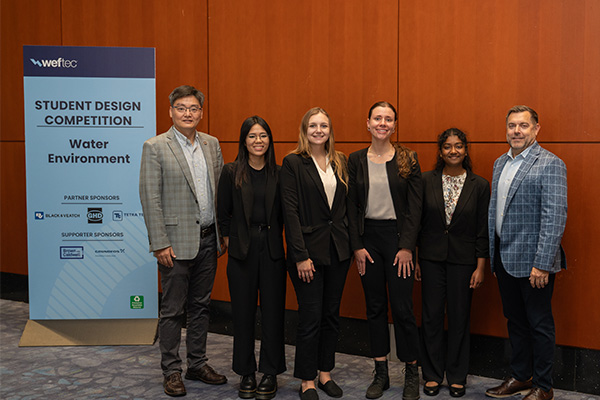WashU students win first places at the 2025 Midwest Student Design Competition
Two student teams presented their projects to water industry professionals, earning top honors

Two student teams from Washington University in St. Louis won top honors at the 2025 Midwest Student Design Competition (MSDC), held April 22, 2025, in Madison, Wisconsin. It is the first time the WashU teams have won first place in the wastewater design and water environment categories since a WashU team began participating in 2023.
The WashU teams were sponsored by the competition organizer, MSDC and the Central States Water Environment Association, with additional support from the Center for Water Innovation at WashU.
Both teams, led by Grace Duong, a first-year doctoral student in the lab of Zhen (Jason) He, the Laura & William Jens Professor in the Department of Energy, Environmental & Chemical Engineering in the McKelvey School of Engineering and an Olin Chancellor’s Fellow, competed against peer institutions from across the Midwest. Students choose to participate in one of three categories: wastewater design, water environment and Global Water Stewardship. In each category, students must identify a real-world environmental problem, develop an engineering solution and present their proposal to a panel of industry professionals.
Duong said the decision to compete in the wastewater design and water environment categories was driven by a desire to address problems with direct impacts on local communities.
“A personal priority for me was to focus on problems close to home,” Duong said. “Growing up in St. Louis, I wanted to work on issues that affect the community I’ve been a part of my whole life. That connection made the work much more meaningful.”
The team members who participated in the wastewater design category included Duong, Kate Martin, Sally Carrington and two other students from Professor Zhen (Jason) He’s lab: Paloma Santiago and Soyoung Park. They presented a project titled Microbial Electrosynthesis for Biogas Purification.
Biogas, a byproduct of anaerobic digestion in wastewater treatment, contains a mix of methane, carbon dioxide, nitrogen and trace gases such as hydrogen sulfide and oxygen. While some treatment plants already use biogas to generate energy, its low methane concentration means it often falls short of the standards required for natural gas pipelines. The team proposed an innovative alternative: microbial electrosynthesis, a process that not only removes carbon dioxide but converts it into additional methane using microbes, electrodes and renewable electricity.
“This approach can boost methane yield while reducing greenhouse gas emissions, improving both the economic and environmental outcomes,” Duong said.
The team members who participated in the water environment category included Duong, Lindsey Feeley, Naomika Raveendran and Alexa Wienhoff. They presented a project titled Coldwater Creek Restoration: Uranium Sequestration.
The idea for the project originated with Duong’s team member Wienhoff, who learned about the Coldwater Creek contamination in an environmental justice class at WashU. The creek, which runs through north St. Louis County, has been polluted with radioactive waste dating back to the 1940s. Despite growing concerns from residents about cancer clusters and other health issues, the problem has remained largely overlooked by regulatory agencies.
The team focused on calculating the social and health-related costs of inaction. Instead of using a traditional return-on-investment analysis, the team calculated the healthcare burden linked to prolonged exposure to radioactive contamination. Using community surveys and national cancer statistics, the team estimated that the total healthcare cost associated with increased cancer rates in the affected areas could reach about $89 million.
Duong said the experience of the MSDC gave her a deeper understanding of the complexity behind environmental engineering projects.
“Working on these projects made me realize how complex real-world environmental challenges truly are,” Duong said. “One of the biggest difficulties was narrowing the scope enough to fit into a 15-minute presentation. In practice, countless technical, economic and logistical details have to be considered.”
Duong said her coursework and lab experiences at WashU played a crucial role in preparing her for the competition.
“I'm finishing a course on physical and chemical processes for drinking water treatment, taught by Professor Dan Giammar (the Walter E. Browne Professor of Environmental Engineering at the McKelvey School of Engineering),” Duong said. “Professor Giammar’s course was directly applicable to our work, particularly for the reactor design and contaminant removal calculations. In addition, my lab work this semester on electrochemical cells gave me hands-on experience that helped me understand and apply similar processes in the wastewater treatment project.”
Reflecting on the experience, Duong noted that being part of an all-women team made the opportunity even more meaningful.
“Our team was entirely composed of women,” Duong said. “Coming from a predominantly male undergraduate program, it was incredibly meaningful to represent women at a competition like this.”




